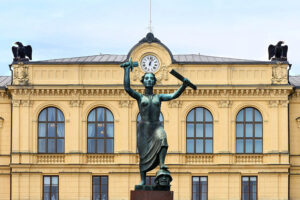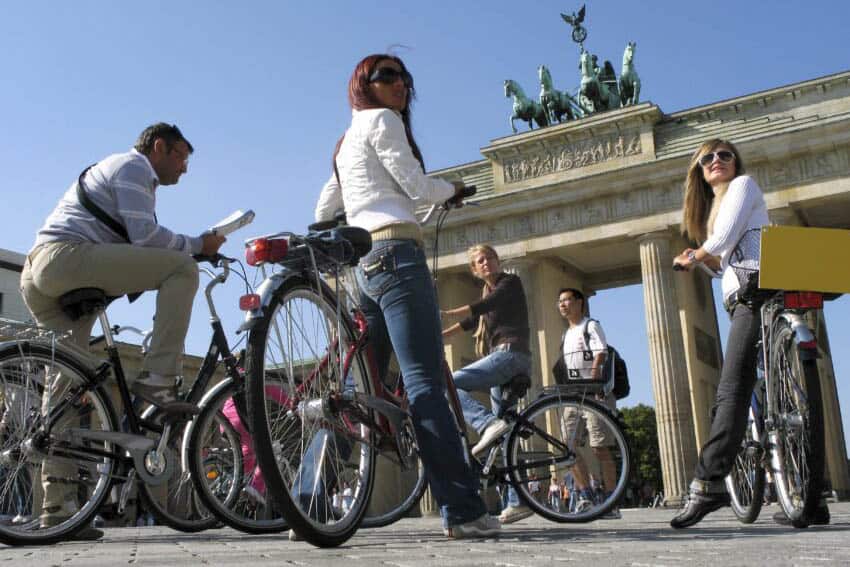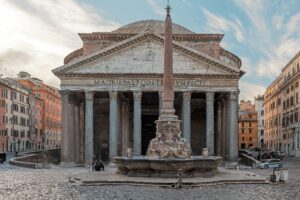
“Roma! Roma! Roma!” — In Rome, Sport and AS Roma is a Passion
by Matt Genner
Alessandro sits with his head buried in the pages of the Corriere dello Sport waiting for the barista to bring him his gran caffé. AS Roma play Catania at the Stadio Olimpico in less than five hours and he can’t wait for the match.
“Roma is my life, my passion”, he says. “It’s football, football, football. You can see how important football is to the people here by walking down the residential streets on a Sunday afternoon.”
“When the match is on, the streets are deserted. All you can hear are the televisions behind the shutters tuned to whichever match is on.”
The coffee at Sant Eustachio is some of the best available in Rome and at times it can be difficult to get through the door as locals and tourists alike compete for the little room there is at the bar.
Getting to the Stadium
Their specialty, the gran caffé, is the perfect start to the day and as Alessandro tells me about the AS Roma Ultras and the Curva Sud, their fan club, I can’t wait to get inside the ground. But wait I will have to  as I have decided to walk to the stadium.
as I have decided to walk to the stadium.

Leaving Alessandro and the sweet-tasting coffee behind, I stroll past the Pantheon, ticket in hand, and head north up the Via del Corso.
Not far along Rome’s main shopping street is the AS Roma Club Store and in a bid to fit in with the rest of the Romanista, I decide to purchase a maroon red scarf with ‘Totti’ stitched in white. It’s hard to avoid the name of Roma’s most famous player in the Eternal city, with every sports and souvenir shop selling Totti shirts, To
tti scarves and Totti mugs.
Further along the Via del Corso, just before you get to the Spanish Steps, is another symbol of Italian sport in the form of Ferrari’s Rome store. Inside you can find models of many cars spanning the last hundred years, including a limited edition replica of Michael Schumacher’s championship-winning car. Like a genuine Ferrari, however, many of the items on sale are extremely expensive.
Having passed the uncomfortably crowded Piazza di Spagna and Spanish Steps the Piazza del Popolo marks the end of the Via del Corso. One of Rome’s largest squares is a welcome break from the busy shopping street.

Legendary Sport Landmarks
I cross the Tiber at the Ponte Regina Margherita, where I can see the unmistakable Saint Peter’s Basilica and the Castel Sant Angelo.
It’s difficult to drag my gaze away from these legendary landmarks but continuing to follow the Tiber north, I leave the tourist areas of Rome behind. Now the people passing me no longer carry guidebooks and cameras, instead they hold furled flags and wear the maroon red of Roma.
A giant obelisk, raised to salute Mussolini, marks the entrance to the Foro Italico. It’s currently undergoing renovation but is just one of several monuments around the complex proclaiming the successes of Fascism.
What an intriguing mixture of scenes: the serene Monte Mario providing the backdrop to the shimmering glass and metal of the Olimpico; thousands of fans teaming over the Tiber, flags in hand, their excitement audible whether you speak Italian or not; all around political slogans and proclamations and way back in the distant city, the silhouette of Saint Peter’s.
The Other Team

Maroon is the color today: the giallorossi are at home. But if my trip had taken place on another day my view would have been tinged with white and sky-blue, as the Olimpico is also the home of Rome’s other Series A team, Lazio.
The rivalry between the two teams is fierce with a historically political divide. Lazio supporters traditionally come from the provincial towns surrounding Rome and have a history of extreme right-wing sympathies. Roma’s support tends to come from the working-class and left-leaning areas of the city, such as Testaccio where the team used to play at the Campo Testaccio.
Having finished my pre-match pizza at the laid-back Riverside Café, I head into the Foro Italico. Entering the stadium, I’m surprised at how easy it is to get through the turnstiles.
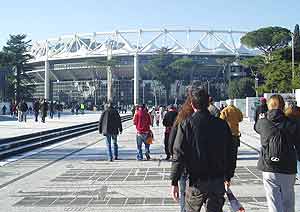
Following the recent troubles in Italian football there have been numerous stories about tougher security and heavy-handed policing but as I stroll up to the gate I show my ticket and enter the ground; no queues, no searches and no signs of trouble.
Underneath the vast stands, fans flick through the free copies of the Impero Romanista, one of several free papers handed out before matches, and converse over an espresso.
I decide to be a little more adventurous and down a shot of Caffé Campione, a coffee liqueur. The sickly taste lingers in the mouth but it’s invigorating and awakens the senses.
Climbing the steps through the stands I emerge into the vast bowl of the Olimpico and find my seat in the Tribuna Terva. To my left, the Curva Sud is full. It’s an incredible scene, everyone standing, jumping around and making an incessant noise.

“Roma, Roma, Roma”
Unlike the rise and fall of a chanting English crowd, the Curva sings. Flares, flags and banners are everywhere and the mixture of smoke and sunlight creates a hazy glow over the stand.
Just minutes before the start everyone around the ground rises, lifting their scarves they belt out the club’s anthem and motto: ‘La Roma non si discute si ama’, roughly translated as ‘Rome is not discussed, it is loved’. “Roma, Roma, Roma”.
I can join in the chorus but I leave the rest to the true supporters.
As the game progresses, the noise from the Ultras is relentless. In the Tribuna Terva, however, the fans are more subdued as their support ebbs and flows with the game.
A fan arriving
The crowd around me are critical and spontaneous. People move seats, shuffling around to express their opinions and their grievances to fellow supporters. Despite the 2-0 score line most seem unhappy with the performance of the team. But as the final whistle blows, the loudspeaker pumps out ‘Grazie Roma’ and everyone files out of the stadium content to be three points closer to the league leaders.
The Political Power of Sport
Leaving the Stadio Olimpico behind me, I move for a closer look at the Stadio del Marmi, a much smaller structure in the Foro Italico. It is part of a series of sports arenas and artwork commissioned by Mussolini in the 1930’s.
The marble stadium is circled by statues of muscular athletes, performing a variety of sports, that were donated by 60 Italian cities to the dictator. The area is surrounded by thousands of square feet of mosaics depicting athletes and soldiers.
The Power of Sport
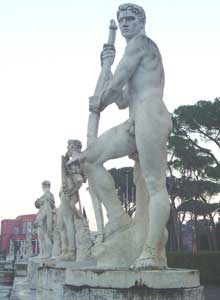
Indeed it was Mussolini, more than most, who realized the political power of sport, hence his desire to build the Foro Italico. Physical perfection and sporting success were vehicles for Fascism to show the world what it had achieved.
Sport and politics are, in many ways, still as closely linked in Italy today. If you’re an important political figure you’re very likely to own a football team.
Increasing Popularity of Rugby
While football is certainly Italy, and Rome’s sporting passion, others still have a popular following.
Having walked from the city center to the ground I decided that I’ll get the bus back. Before doing so I head towards one of the other stadiums in northern Rome, the Stadio Flaminio, which hosts the Italian national rugby team and the matches of AS Cisco Calcio Roma, who play in Serie C and are currently the club of Paolo Di Canio.
Due to the increasing popularity of rugby in Italy, there is much debate as to whether the Flaminio is large enough to host the national team, the Azzurri, but, for the next few years at least, Six Nations Championship fans will be visiting this area in northern Rome.
There’s not a lot to see or do as I walk around but when there’s a game many food and drink stalls are set up and there’s a large open-air market nearby.

And Basketball…
Walking to catch the bus back to the city center, I notice a group of teenagers playing basketball near the Flaminio on an old rundown court. Basketball is very popular in Italy’s urban areas and several of them are wearing the vests of Virtus Roma.
One of the players tells me that they come here every week to play and that they prefer to watch basketball than football. Virtus play at the Palazo dello Sport in southern Rome, which was built for the 1960 Olympics and is part of another Fascist complex, the Esposizione Universale Roma.
The Palazo dello Sport, shaped like a flying saucer, is closed and fenced off as I walk by. There is no game this weekend so I make do by observing from afar.
It was here, during the Olympics, that short rowing contests took place in the lake surrounded by gardens in front of the arena.
Another Fascist Complex
Sitting above the rest of the EUR, I look over the complex at some of the impressive architecture.
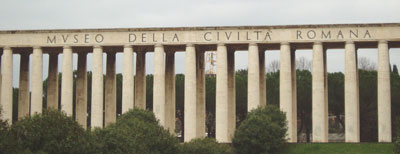
The Fascist regime used this area and others in Rome to demonstrate the link between the expansion of the Roman Empire and its own plans for Rome to grow in size and influence.
There are many museums scattered around and I decide to visit the Museo della Civilta Romana. Constructed in 1937, as part of Mussolini’s celebrations to mark 2000 years since Emperor Augustus ruled Ancient Rome, the giant white structure with vast echoing rooms, allows you to trace the history of Imperial Rome in a grandiose setting.
Towards the end of the exhibitions is the museum’s highlight, a giant model of Rome in the third century. Gazing at the many famous landmarks, I can pick out several sports arenas. Sport, it seems, was as popular in Rome 2000 years ago as it is today.

Ancient Roman Sport
It’s not until you get inside the Colosseum that you realize what a magnificent arena it must have been. Standing at ground level I gaze up at the most complete side of the structure.
The remains of the stands seem so much steeper than modern stadiums, almost vertical, and when full, it must have felt like the crowd would fall on top of you. It was here that for the first time sport was widely used as a form of mass entertainment.
A short walk from the Colosseum, around Palatine Hill, and I find myself looking down on what is left of Rome’s largest racetrack, the Circus Maximus. There is not much left of this great venue but with a little help from my imagination I conjure up an image of the stands that held up to 300,000 spectators.
The ancient Roman sports may have been very different from the codified spectacles we watch today, but many factors that permeated sport then still hold true today. The gladiatorial contests and chariot races that took place were used to occupy the masses, distracting them from what was really happening and raising the popularity of senators and emperors.
Similar distinctions can be seen today as political figures seek to back bids for sporting events and associate themselves with sports teams and achievements.
These affiliations are more obvious and significant in Italy than most nations. Indeed, when president Romano Prodi stood for election against Silvio Berlusconi he created an image of himself as a cyclist to counter the sporting success his opponent enjoyed with AC Milan.
A ‘Culture of Conversation’
As the evening draws in I head to the Trastevere district of Rome, a delightful area of narrow streets where tourists and locals mix in the excellent cafés, bars and restaurants.

In his book, Culture and Customs of Italy, Charles Killinger states that Italy’s “culture of conversation can be seen as a product of a variety of influences.”
Now, as I sit in anticipation of the food to come and think back over the sporting venues, sites and famous landmarks I have seen, all around me people are talking about yesterday’s game.
It’s the culture of conversation that Killinger spoke about that makes talking to any Italian about sport a fascinating experience.
Surely, I ponder, there is no greater journey to a sports stadium than the walk from central Rome to the Stadio Olimpico.
In the ninety minutes it took me to reach the ground, I had gazed upon some of the most famous buildings of Ancient and Papal Rome. Alessandro was right, sport means a great deal to the citizens of Rome, and as I had also seen, since Imperial times, it always has done.

Matt Genner is a freelance sports journalist based in the UK who is now starting out as a travel writer. He hopes to combine his love of watching and playing sport with the excitement of traveling the globe.
Eurail Passes: What to Know about Buying a Europe Train Pass
- These 9 U.S. National Parks Require Reservations in 2024 - April 17, 2024
- Take a Hike in Olympic National Park - April 17, 2024
- The Wild Mississippi: 2340 Miles Across Ten States - April 8, 2024



